Improvement in Food Resources Class 9 Notes Science Chapter 12
| Table of contents |

|
| Introduction |

|
| Improvement in Crop Yields |

|
| Nutrient Management |

|
| Cropping Patterns |

|
| Animal Husbandry |

|
| Fish Production |

|
Introduction
Improvement in Food Resources refers to the methods aimed at increasing the quantity and quality of food produced through agriculture and animal husbandry to meet the growing demand for food sustainably.
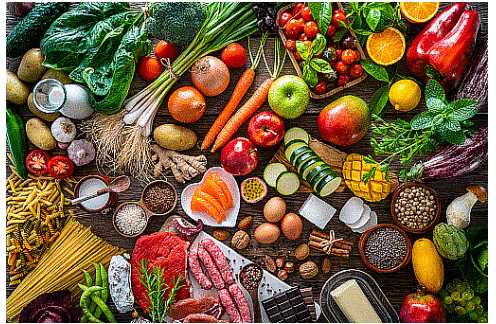 Various Food Resources
Various Food Resources
As living organisms, food is essential for our growth, health, and overall development. We obtain food primarily from plants and animals through agriculture and animal husbandry. With India's growing population, the demand for food is rising, and it is crucial to find ways to increase food production efficiently.
This chapter focuses on:
- The need to improve crop and livestock production to meet food demand.
- Successes like the Green Revolution and the White Revolution boosted food and milk production.
- The importance of sustainable practices in agriculture and animal husbandry to protect natural resources.
- The connection between food security, increased production, and access to food.
- Scientific methods like mixed farming, intercropping, and integrated farming improve yields without harming the environment.
Improvement in Crop Yields
Food Crops and Their Nutritional Benefits
- Cereals such as wheat, rice, maize, millets, and sorghum provide us with carbohydrates for energy.
- Pulses like gram (chana), pea (matar), black gram (urad), green gram (moong), pigeon pea (arhar), and lentil (masoor) supply us with protein.
- Oilseeds, including soybean, groundnut, sesame, castor, mustard, linseed, and sunflower, offer essential fats.
- Vegetables, spices, and fruits deliver a variety of vitamins and minerals, along with small amounts of proteins, carbohydrates, and fats.
- Fodder crops like berseem, oats, or Sudan grass are grown for livestock feed.
 Different Types of Crops in India
Different Types of Crops in India
In India, the production of food grains has increased fourfold from 1952 to 2010, while the area of land available for cultivation has only risen by 25%.
Factors Affecting Crop Growth
- Different crops need specific climatic conditions, temperature, and sunlight duration (photoperiods) to grow and complete their life cycles.
- Plants gather energy through photosynthesis, which relies on sunlight.
- During the Kharif season (June to October), crops like paddy, soybean, pigeon pea, maize, cotton, green gram, and black gram flourish.
- In the Rabi season (November to April), crops such as wheat, gram, peas, mustard, and linseed do well.
Major Activities for Improvement:
- Crop Variety Improvement: Enhancing crop types to maximise yields, ensuring high production under diverse conditions.
- Crop Production Improvement: Implementing methods to increase overall crop output.
- Crop Protection Management: Taking measures to protect crops from damage and loss.
Let's Revise
Q: What nutrient do cereals like wheat and rice provide?
 View Answer
View Answer 
Ans: Cereals provide carbohydrates which give energy.
Q: Name any two crops grown during the Kharif season.
 View Answer
View Answer 
Ans: Paddy and maize are two crops grown in the Kharif season.
Crop Variety Improvement
Methods for Crop Variety Improvement
- Breeding for beneficial traits: Selecting varieties with qualities such as disease resistance and high yields.
- Hybridisation: Crossing genetically different plants, which can be intervarietal, interspecific, or intergeneric.
- Genetic modification: Introducing specific genes to achieve desired traits in crops.
The factors for which variety improvement is done are:
- Higher yield: To boost crop productivity per acre.
- Improved quality: Quality requirements vary by crop; for instance, baking quality is crucial in wheat, while protein quality is essential in pulses.
- Biotic and abiotic resistance: Creating varieties that can withstand diseases, insects, drought, salinity, and extreme temperatures.
- Change in maturity duration: Shorter periods from sowing to harvesting enhance economic viability, enabling multiple crops per year.
- Wider adaptability: Developing varieties that can thrive in various environmental conditions stabilises crop production.
- Desirable agronomic characteristics: Traits like height and branching are advantageous for fodder crops, while shorter plants are preferred in cereals to minimise nutrient consumption.
Crop Production Management
- In India, as in many other agriculture-focused countries, farming varies from small to very large farms.
- Consequently, farmers have differing amounts of land, resources, and access to information and technology.
- Financial conditions significantly influence the farming practices and technologies that farmers can adopt.
- Cultivation methods and crop yield depend on factors like weather, soil quality, and water availability.
- Since weather conditions, such as drought or floods, can be unpredictable, varieties that grow well in various climatic situations are beneficial.
- Similarly, varieties that tolerate high soil salinity have also been developed.
Nutrient Management
Plant Nutrients
- Essential nutrients: Plants need nutrients from air, water, and soil for growth. Air provides carbon and oxygen, water supplies hydrogen, and soil provides the other thirteen nutrients.
- Macro-nutrients: These are nutrients required in large amounts, including carbon, oxygen, hydrogen, and others from the soil.
- Micro-nutrients: These are needed in smaller quantities and are also supplied by the soil.
A lack of these nutrients can negatively impact plant growth, reproduction, and disease resistance.

Deficiency of these nutrients affects reproduction, growth, and susceptibility to diseases in plants.
Manure
Manure is an organic substance made from the decomposition of animal waste and plant materials. It is rich in organic matter and essential nutrients, which help improve soil fertility and support healthy plant growth.
Benefits of Manure:
- Enriches the soil by adding organic matter and nutrients.
- Improves soil structure, which:
1. Increases water retention in sandy soils.
2. Enhances drainage and reduces waterlogging in clayey soils. - Environmentally friendly: It recycles biological and farm waste, reducing the dependence on chemical fertilisers and helping lower water pollution.
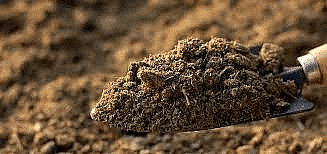 Manure
Manure
Types of Manure
(i) Compost and vermicompost:
- Composting: This involves breaking down waste like animal dung and vegetable scraps to create nutrient-rich compost.
- Vermicomposting: In this method, earthworms are used to speed up decomposition, resulting in vermicompost.
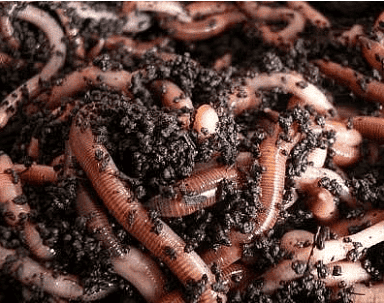 Vermicomposting
Vermicomposting
(ii) Green manure: Plants such as sun hemp or guar are grown before planting other crops. When these plants are turned into the soil, they enrich it with nitrogen and phosphorus.
Let's Revise
Q: How does manure improve soil fertility?
 View Answer
View Answer 
Ans: Manure enriches the soil with organic matter and essential nutrients, improving its fertility.
Q: Why is green manure used before sowing crops?
 View Answer
View Answer 
Ans: Green manure adds nitrogen and phosphorus to the soil, enhancing nutrient availability for the next crop.
Fertilisers
- Fertilisers are commercially manufactured nutrients that provide nitrogen, phosphorus, and potassium.
- They are essential for promoting the healthy growth of leaves, branches, and flowers, leading to robust plants.
- Fertilisers play a major role in increasing crop yields, especially in intensive farming.
- Careful application of fertilisers is crucial, including the right amounts, timing, and following guidelines before and after use for full effectiveness.
- Excessive watering can wash fertilisers away, leading to water pollution.
- Repeated use of fertilisers in one area can harm soil fertility since the soil's organic matter isn’t restored.
- Green manure, made by growing specific plants and turning them into the soil, enriches the soil with nitrogen and phosphorus.
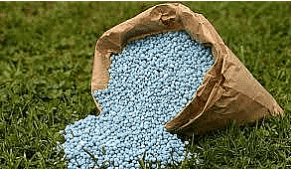 Fertilisers
Fertilisers
Benefits and Considerations of Fertilisers
- Boosts plant growth: Fertilisers deliver key nutrients like nitrogen, phosphorus, and potassium, fostering healthy growth.
- Increases yields: When used correctly, fertilisers can enhance crop productivity in high-cost farming.
- Soil health impact: Regular use of fertilisers can deplete soil fertility as it does not replenish organic matter and can harm beneficial soil microorganisms.
Proper Application and Precautions
- While aiming for maximum crop yields, consider the quick benefits of fertilisers alongside the long-term advantages of manure for soil health.
- Fertilisers need to be applied carefully, focusing on the right amount and timing to ensure they are fully used by plants.
Organic farming is a method that minimises or eliminates the use of chemical fertilisers, herbicides, and pesticides. It maximises the use of organic manures, recycled farm waste such as straw and livestock dung, and employs natural agents like blue-green algae for creating biofertilisers. Additionally, neem leaves or turmeric can be used as natural pesticides during grain storage, promoting healthier farming systems.
Organic Farming
- Organic farming reduces or eliminates the use of chemicals like fertilisers, herbicides, and pesticides.
- Instead, it focuses on maximising the use of organic manures, recycled farm waste (like straw and livestock excreta), and bio-agents, such as cultures of blue-green algae for biofertilisers.
- Additionally, neem leaves or turmeric can serve as bio-pesticides for grain storage.
- Healthy cropping systems, including mixed cropping, inter-cropping, and crop rotation, are used to enhance control of insects, pests, and weeds while providing essential nutrients to crops.
Irrigation
Proper irrigation is very important for the success of crops. Most agriculture in India relies on rain, meaning the success of crops in many areas depends on timely monsoons and adequate rainfall throughout the growing season. Therefore, poor monsoons can lead to crop failure. Ensuring that crops receive water at the right times during their growing season can boost the expected yields of any crop.
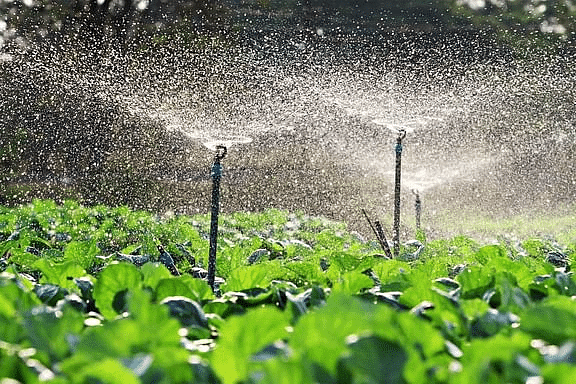 Irrigation
Irrigation
Types of Irrigation Systems
- Wells: There are two types of wells: dug wells and tube wells. A dug well collects water from shallow water-bearing layers, while a tube well can reach deeper water sources. Pumps are used to lift water from these wells for irrigation.
- Canals: This is usually a large and complex irrigation system. Canals receive water from one or more reservoirs or rivers. The main canal splits into branch canals, which have further distributaries to irrigate fields.
- River lift system: In areas where canal flow is inconsistent due to insufficient reservoir release, this system is more effective. Water is taken directly from rivers to support irrigation in nearby areas.
- Tanks: These are small storage reservoirs that collect and store runoff from smaller catchment areas. New initiatives to increase available water for agriculture include rainwater harvesting and watershed management. This involves creating small check dams, which help raise groundwater levels. The check dams prevent rainwater from flowing away and reduce soil erosion.
Droughts occur due to a lack or irregular distribution of rain. Drought poses a risk to rain-fed farming areas, where farmers rely solely on rain for crop production. Light soils hold less water, and in such areas, crops are negatively affected by drought conditions.
Cropping Patterns
Cropping patterns refer to various methods of growing crops to achieve the best results.

Types of Cropping Patterns
- Mixed cropping: Growing two or more crops at the same time on the same land, such as wheat with gram, wheat with mustard, or groundnut with sunflower. This method reduces the risk of disease and helps protect against crop failure.
- Inter-cropping: Planting two or more crops together in a specific pattern, like rows of soybean alternating with rows of maize, or finger millet (bajra) with cowpea (lobia). This ensures that each crop has different nutrient needs, optimising nutrient use and reducing pest and disease spread.
- Crop rotation: Growing different crops on the same land in a planned sequence. The choice of crops depends on moisture availability and irrigation. Proper crop rotation can allow for two or three successful harvests in a year.
Crop Protection Management
- Field crops face many threats from weeds, insects, and diseases. Managing these threats timely manner is crucial to avoid significant crop damage and losses.
- Weeds: Unwanted plants in the fields, such as Xanthium (gokhroo), Parthenium (gazar ghas), and Cyperus rotundus (motha). They compete for resources, reducing crop growth. Therefore, removing weeds early is essential for a good harvest.
- Insect pests: They harm plants in three main ways: by cutting roots, stems, and leaves; by sucking sap; and by boring into stems and fruits, all of which can lower crop health and yields.
- Diseases: Caused by pathogens like bacteria, fungi, and viruses, which can spread through the soil, water, and air, leading to reduced crop health.
Let's Revise
Q: What is inter-cropping? Name a crop combination used in intercropping.
 View Answer
View Answer 
Ans: Inter-cropping involves growing two or more crops in a definite pattern, such as alternating rows. Soybean and maize is a common inter-cropping pair.
Q: How do insect pests damage crops?
 View Answer
View Answer 
Ans: By cutting parts, sucking sap, or boring into stems and fruits.
Methods of Control
- Pesticides: These include herbicides, insecticides, and fungicides, which are applied to crops or seeds and soil. However, overuse can be harmful to various plants and animals, and it can lead to pollution of the environment.
- Mechanical removal: This involves physical methods, such as manual weeding, to manage weed growth.
- Preventive measures:
- Seed bed preparation: Properly preparing the seed bed and timely sowing of crops can help prevent weed growth.
- Intercropping & crop rotation: Planting multiple crops together or rotating them can lessen the impact of pests and diseases.
- Resistant varieties: Using crop varieties that resist pests and diseases.
- Summer ploughing: Deep ploughing in summer to eliminate weeds and pests, reducing their effect on future crops.
Storage of Grains
Storage losses in agricultural products can be quite high. The causes of these losses are biotic factors—like insects, rodents, fungi, mites, and bacteria—and abiotic factors, such as improper moisture and temperature in storage. These issues can lead to:
- Decline in quality
- Weight loss
- Reduced germination
- Discolouration of produce
- Poor marketability

Control Measures
Preventive Measures
- Preventive and control measures are implemented prior to storing grains.
- Thorough cleaning of the produce is essential.
- Proper drying should be done in both sunlight and shade.
- Fumigation with pest-control chemicals is necessary.
- Effective seedbed preparation, timely sowing of crops, intercropping, and crop rotation assist in controlling weeds.
- Utilising resistant varieties and summer ploughing can help eliminate weeds and pests.
Systematic Warehouse Management
- This is vital for minimising storage losses.
- The process involves organised treatment of grains and effective management of warehouses.
Animal Husbandry
- Animal husbandry is the scientific management of livestock, which includes activities such as feeding, breeding, and controlling diseases.
- This type of farming involves animals like cattle, goats, sheep, poultry, and fish.
- As the population grows and living standards improve, the demand for milk, eggs, and meat also increases.
- Moreover, there is a heightened awareness about the humane treatment of livestock, leading to new considerations in farming practices.
- Therefore, there is a need to enhance livestock production to meet these rising demands.
Cattle Farming
- Cattle farming serves two main purposes: producing milk and providing draught power for agricultural tasks like ploughing, watering, and transporting goods.
- In India, cattle are classified into two species: Bos indicus (cows) and Bos bubalis (buffaloes).
- Female animals that produce milk are referred to as milch animals, while those used for labour are known as draught animals.
- The amount of milk produced is influenced by the lactation period, which is the time after a calf is born during which the mother produces milk.
- This production can be enhanced by extending the lactation period.
- Exotic breeds (like Jersey and Brown Swiss) are often chosen for their longer lactation periods, whereas local breeds (such as Red Sindhi and Sahiwal) are known for their strong disease resistance.
- Cross-breeding these types can result in animals that possess both desirable traits.
- Animals like cows and buffalo need clean shelters for their health and to ensure they produce clean milk. They should be kept in well-ventilated sheds that protect them from rain, heat, and cold. The floor of the shed should slope to stay dry and make cleaning easier.
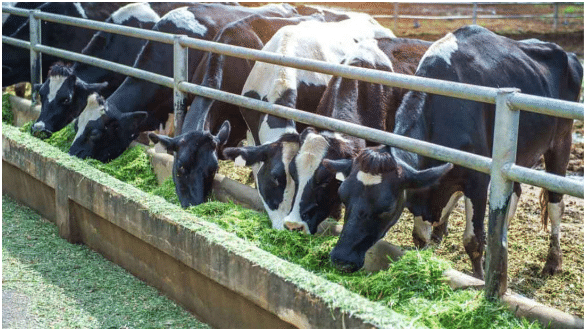 Cattle Farming
Cattle Farming
Feeding Requirements
- Dairy animals have two types of nutritional needs:
(a) maintenance requirement, which keeps them healthy, and
(b) milk-producing requirement, which is essential during lactation. - Animal feed consists of
(a) roughage, which is high in fibre, and
(b) concentrates, which are lower in fibre but rich in proteins and nutrients.
Cattle require a balanced diet that provides all necessary nutrients in the right proportions. Certain feed additives containing micronutrients can also enhance the health and milk yield of dairy animals.
Diseases and Control
- Cattle suffer from various diseases that reduce milk production and may cause death.
- Healthy cattle eat regularly and have normal posture.
- Parasites can be external (causing skin diseases) or internal, like worms affecting the stomach and flukes damaging the liver.
- Bacterial and viral infections also occur, for which vaccinations are given.
Let's Revise
Q: What are milch animals?
 View Answer
View Answer 
Ans: Milch animals are female animals that produce milk.
Q: Name one exotic and one local breed of cattle.
 View Answer
View Answer 
Ans: Exotic: Jersey; Local: Sahiwal.
Poultry Farming
Poultry farming is the practice of raising birds like chickens for their eggs and meat. Special poultry breeds are created for specific roles: layers produce eggs, while broilers are bred for meat. Cross-breeding between local Indian breeds, such as the Aseel, and foreign breeds like the Leghorn aims to create new varieties with desirable characteristics, which include:
- High numbers and quality of chicks;
- Dwarf broiler parents for commercial chick production;
- Ability to adapt to hot weather;
- Low maintenance needs;
- Smaller egg-laying birds can thrive on cheaper, more fibrous diets made from agricultural by-products.

Egg and Broiler Production
Broiler chickens are raised specifically for meat and sent to market when they are ready. Their diet is rich in protein and contains sufficient fat. The poultry feed includes high levels of vitamins A and K to promote optimal growth and efficient feed usage. Care is taken to minimise mortality and maintain the quality of feathers and meat.
Importance of Good Management Practices
Good management practices are crucial for successful poultry production. This includes:
- Maintaining the housing at the correct temperature;
- Ensuring the environment and feed are clean, which involves regular cleaning, sanitation, and disinfection;
- Preventing and managing diseases and pests through appropriate vaccination which can stop infectious diseases and reduce poultry losses during outbreaks.
The housing, nutritional, and environmental needs of broilers differ somewhat from those of egg layers.
Broilers have different housing, nutritional, and environmental needs compared to egg layers. Their specific diet is designed to support their growth requirements.
Disease Prevention and Control
Poultry can become ill due to:
- Viruses
- Bacteria
- Fungi
- Parasites
- Nutritional deficiencies
Regular cleaning, sanitation, and disinfectant spraying are essential.
- Vaccinations can help prevent infectious diseases and reduce poultry losses during outbreaks.
- Farm animals receive vaccinations against major viral and bacterial diseases.
Poultry in India is the most efficient at converting low-fibre food (not suitable for human consumption) into nutritious animal protein.
Fish Production
- The main aim is that fish serves as an affordable source of protein in our meals.
- Fish production includes various species, such as true finned fish and shellfish like prawns and molluscs.
- Fish can be obtained in two ways: through natural resources, known as capture fishing, or through farming, referred to as culture fishery.
- Fish are found in both seawater and freshwater environments. Marine fisheries and inland fisheries are two major sources.
Marine Fisheries
- India's marine fishery resources include 7500 km of coastline and the deep seas beyond it.
- Popular marine fish found in these waters include pomfret, mackerel, tuna, sardines, and Bombay duck.
- Marine fish are caught using various fishing nets from fishing boats.
- Yields are increased by locating large schools of fish in the open sea using satellites and echo-sounders.
- Some marine fish of high economic value are also farmed in seawater, including finned fish like mullets, bhetki, and pearl spots, shellfish such as prawns, mussels, and oysters, as well as seaweed.
- In such a system, a combination of five or six fish species is used in a single fishpond to avoid competition for food.

Aquaculture in Seawater
- Certain valuable marine fish are grown in seawater through a method called mariculture.
- Examples of farmed finned fish include mullets, bhetki, and pearl spots. Shellfish like prawns, mussels, and oysters are also cultivated.
- Seaweed is another product obtained from mariculture, and oysters are cultivated not only for their meat but also for pearl production.
- As stocks of marine fish are depleted, the demand can only be met through cultured fisheries, a practice known as mariculture.
Let's Revise: Besides meat, why are oysters cultivated?
 View Answer
View Answer 
Ans: For pearl production.
Inland Fisheries
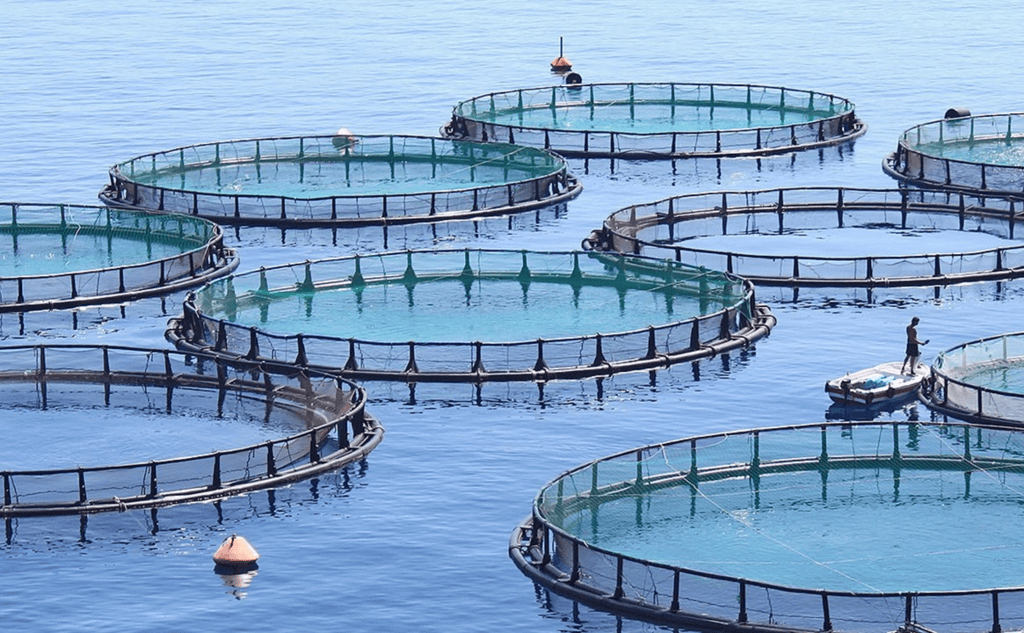 Inland Fisheries
Inland Fisheries
- Freshwater resources consist of canals, ponds, reservoirs, and rivers.
- Brackish water areas, like estuaries and lagoons, are also important for fish.
- While fish are captured in these inland waters, most production comes from aquaculture.
Aquaculture in Freshwater Systems
- Freshwater aquaculture involves raising fish in resources like canals, ponds, reservoirs, and rivers. Fish can also be cultivated in paddy fields, where they grow alongside rice crops, making efficient use of water and land.
- An intensive method used in freshwater aquaculture is composite fish culture, where both local and imported species are reared together. In this system, fish species are carefully selected to avoid competition for food by occupying different zones of the pond:
- Catlas feed at the surface,
- Rohus feed in the middle layer,
- Mrigals and Common Carps feed at the bottom,
- Grass Carps consume aquatic weeds. - This arrangement ensures that all available food in the pond is utilised efficiently, resulting in a higher overall fish yield.
- However, a major challenge in this system is that many fish species breed only during the monsoon. Additionally, fish seed collected from natural sources may get mixed with other species, affecting the purity and quality of the stock.
- To address this issue, scientists have developed methods to breed fish in ponds using hormonal stimulation, which ensures the year-round availability of pure and healthy fish seed in the desired quantities.
Challenges in Fish Farming
- Many fish types in composite fish culture only breed during the monsoon season.
- A significant issue in fish farming is the shortage of quality fish seed.
- To solve this problem, methods have been developed to breed these fish in ponds using hormonal stimulation, ensuring a reliable supply of pure fish seed in the required amounts.
Let's Revise
Q: What is composite fish culture?
 View Answer
View Answer 
Ans: Growing multiple fish species together in the same pond, choosing species that do not compete for food.
Q: Why is pure fish seed supply important in fish farming?
 View Answer
View Answer 
Ans: To prevent mixing of species and ensure healthy, steady production.
Bee-Keeping
Bee-keeping for honey production is a farming activity. Besides honey, beehives also provide wax, which is used in many medicinal products.
- Local bee varieties, such as Apis cerana indica (the Indian bee), A. dorsata (the rock bee), and A. florae (the little bee), are used alongside the Italian bee (A. mellifera) for commercial honey production.
- The Italian bees have high honey collection capacity, sting somewhat less, and stay in a given beehive for long periods.

- The quality of honey depends on the pasturage, and bee farms or apiaries are established for commercial honey production.
- Honey production also provides wax, which is used in various medicinal preparations.
Factors Affecting Honey Quality
- The quality of honey relies on the availability of flowers that bees can gather nectar and pollen from.
- Besides having enough flowers, the types of blooms influence the flavour of the honey.
- Italian bees are known for their high honey production. They are less aggressive, remain in the same hive for extended periods, and breed effectively.
|
84 videos|478 docs|60 tests
|
FAQs on Improvement in Food Resources Class 9 Notes Science Chapter 12
| 1. What are the main methods used to improve food production? |  |
| 2. How does the use of fertilizers impact food resources? |  |
| 3. What role does irrigation play in improving food resources? |  |
| 4. What are the advantages of using high-yielding varieties (HYVs) of seeds? |  |
| 5. How can crop rotation contribute to sustainable food production? |  |
















